Implementing Strategy Analysis Report
VerifiedAdded on 2022/08/18
|17
|3500
|13
AI Summary
Contribute Materials
Your contribution can guide someone’s learning journey. Share your
documents today.
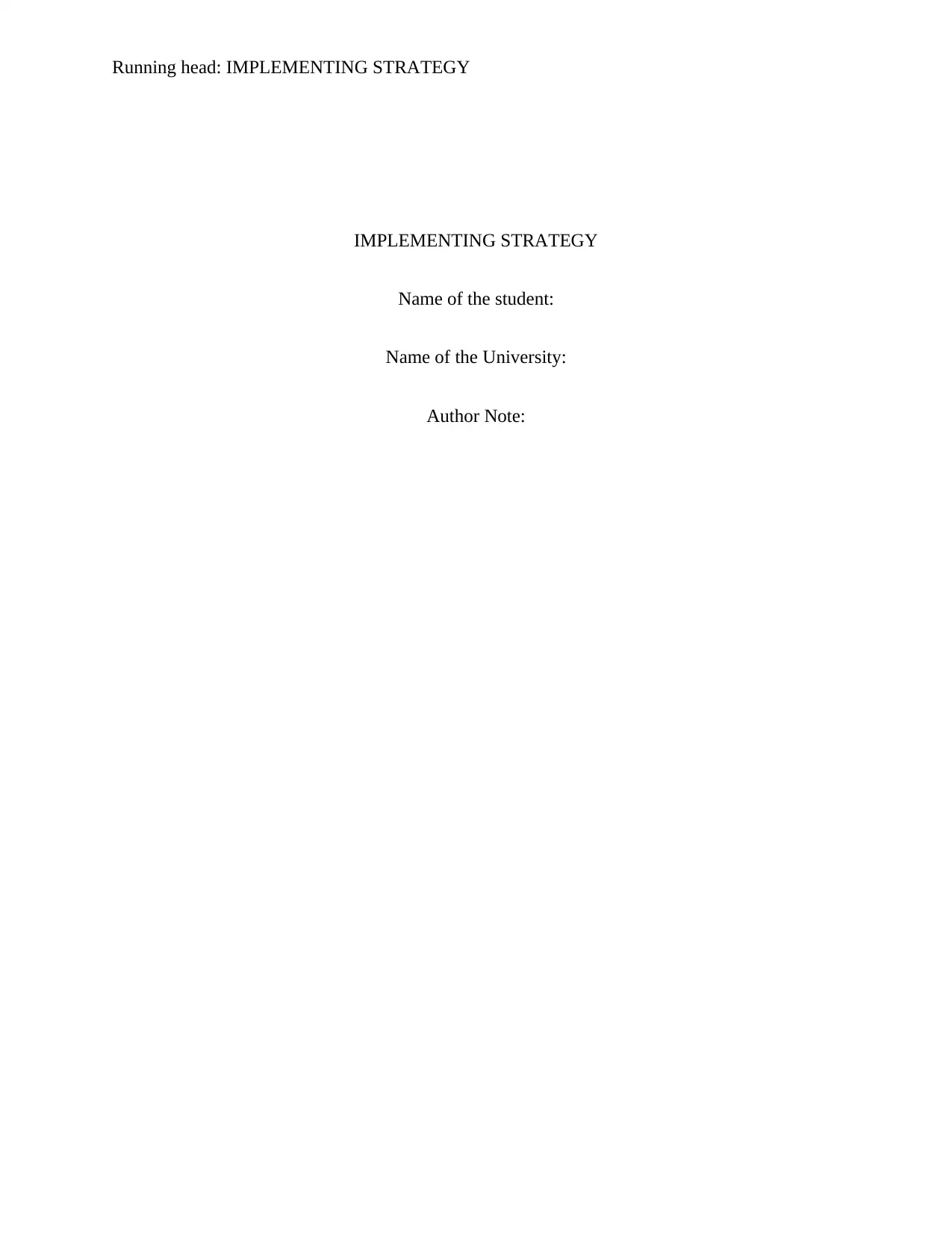
Running head: IMPLEMENTING STRATEGY
IMPLEMENTING STRATEGY
Name of the student:
Name of the University:
Author Note:
IMPLEMENTING STRATEGY
Name of the student:
Name of the University:
Author Note:
Secure Best Marks with AI Grader
Need help grading? Try our AI Grader for instant feedback on your assignments.
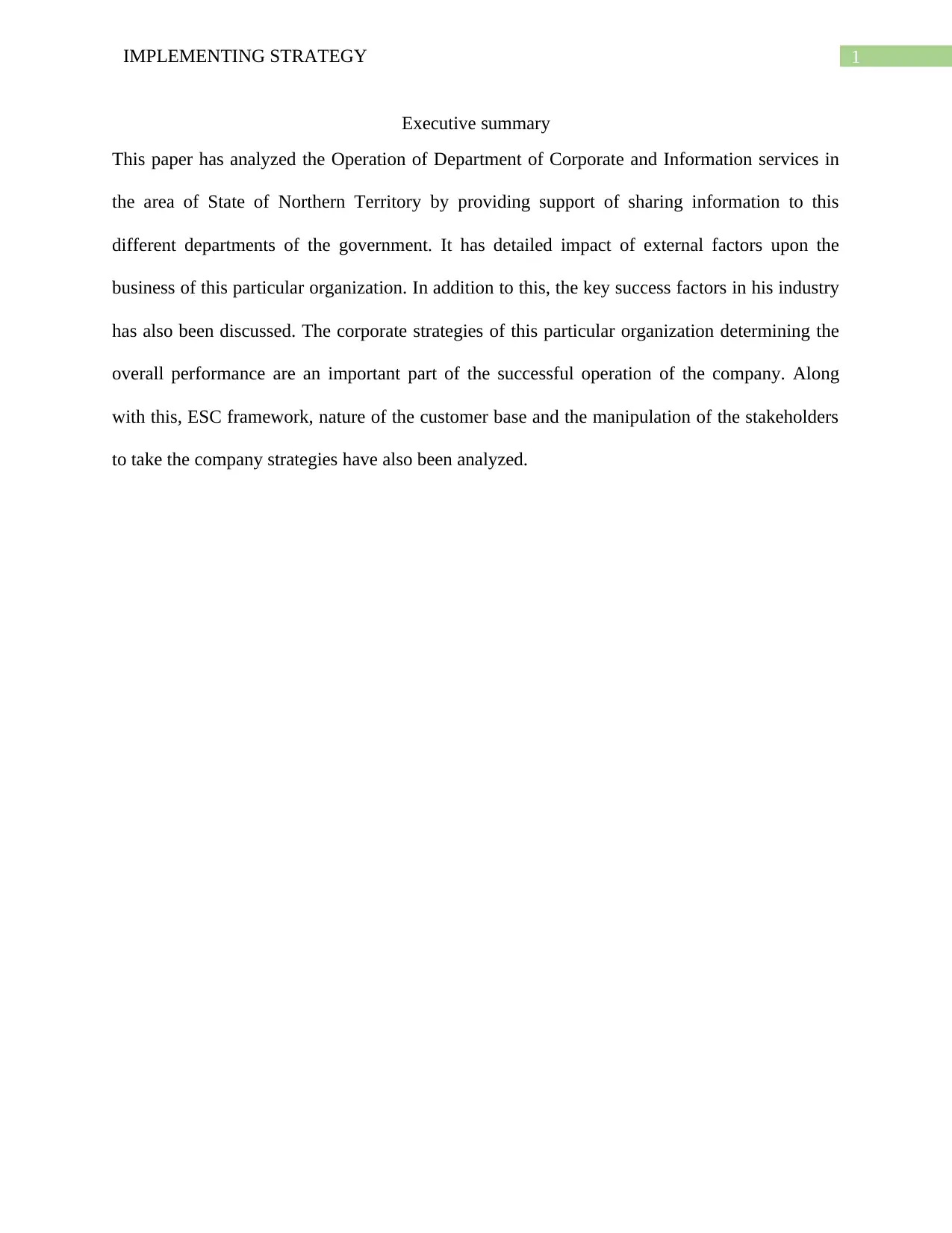
1IMPLEMENTING STRATEGY
Executive summary
This paper has analyzed the Operation of Department of Corporate and Information services in
the area of State of Northern Territory by providing support of sharing information to this
different departments of the government. It has detailed impact of external factors upon the
business of this particular organization. In addition to this, the key success factors in his industry
has also been discussed. The corporate strategies of this particular organization determining the
overall performance are an important part of the successful operation of the company. Along
with this, ESC framework, nature of the customer base and the manipulation of the stakeholders
to take the company strategies have also been analyzed.
Executive summary
This paper has analyzed the Operation of Department of Corporate and Information services in
the area of State of Northern Territory by providing support of sharing information to this
different departments of the government. It has detailed impact of external factors upon the
business of this particular organization. In addition to this, the key success factors in his industry
has also been discussed. The corporate strategies of this particular organization determining the
overall performance are an important part of the successful operation of the company. Along
with this, ESC framework, nature of the customer base and the manipulation of the stakeholders
to take the company strategies have also been analyzed.
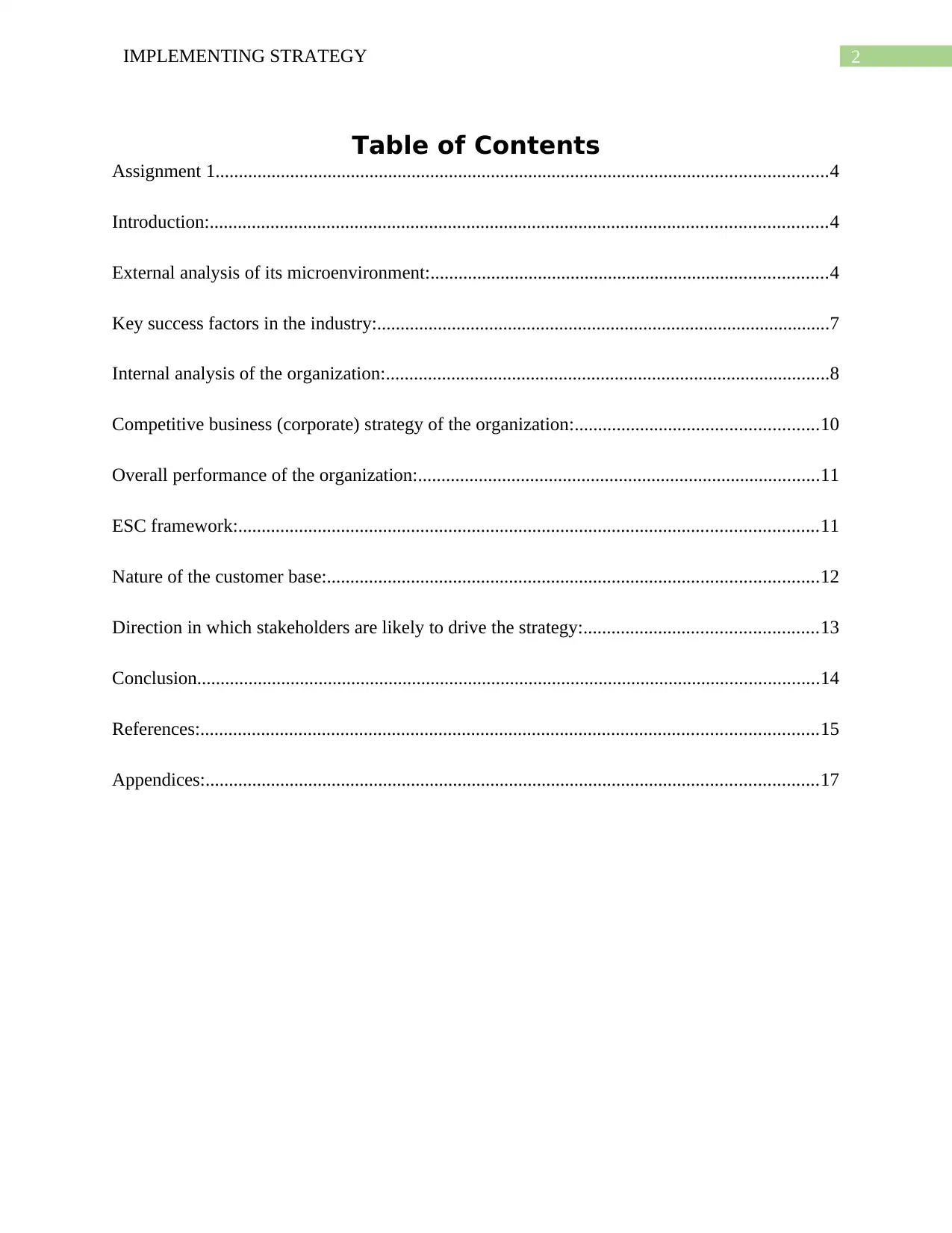
2IMPLEMENTING STRATEGY
Table of Contents
Assignment 1...................................................................................................................................4
Introduction:....................................................................................................................................4
External analysis of its microenvironment:.....................................................................................4
Key success factors in the industry:.................................................................................................7
Internal analysis of the organization:...............................................................................................8
Competitive business (corporate) strategy of the organization:....................................................10
Overall performance of the organization:......................................................................................11
ESC framework:............................................................................................................................11
Nature of the customer base:.........................................................................................................12
Direction in which stakeholders are likely to drive the strategy:..................................................13
Conclusion.....................................................................................................................................14
References:....................................................................................................................................15
Appendices:...................................................................................................................................17
Table of Contents
Assignment 1...................................................................................................................................4
Introduction:....................................................................................................................................4
External analysis of its microenvironment:.....................................................................................4
Key success factors in the industry:.................................................................................................7
Internal analysis of the organization:...............................................................................................8
Competitive business (corporate) strategy of the organization:....................................................10
Overall performance of the organization:......................................................................................11
ESC framework:............................................................................................................................11
Nature of the customer base:.........................................................................................................12
Direction in which stakeholders are likely to drive the strategy:..................................................13
Conclusion.....................................................................................................................................14
References:....................................................................................................................................15
Appendices:...................................................................................................................................17
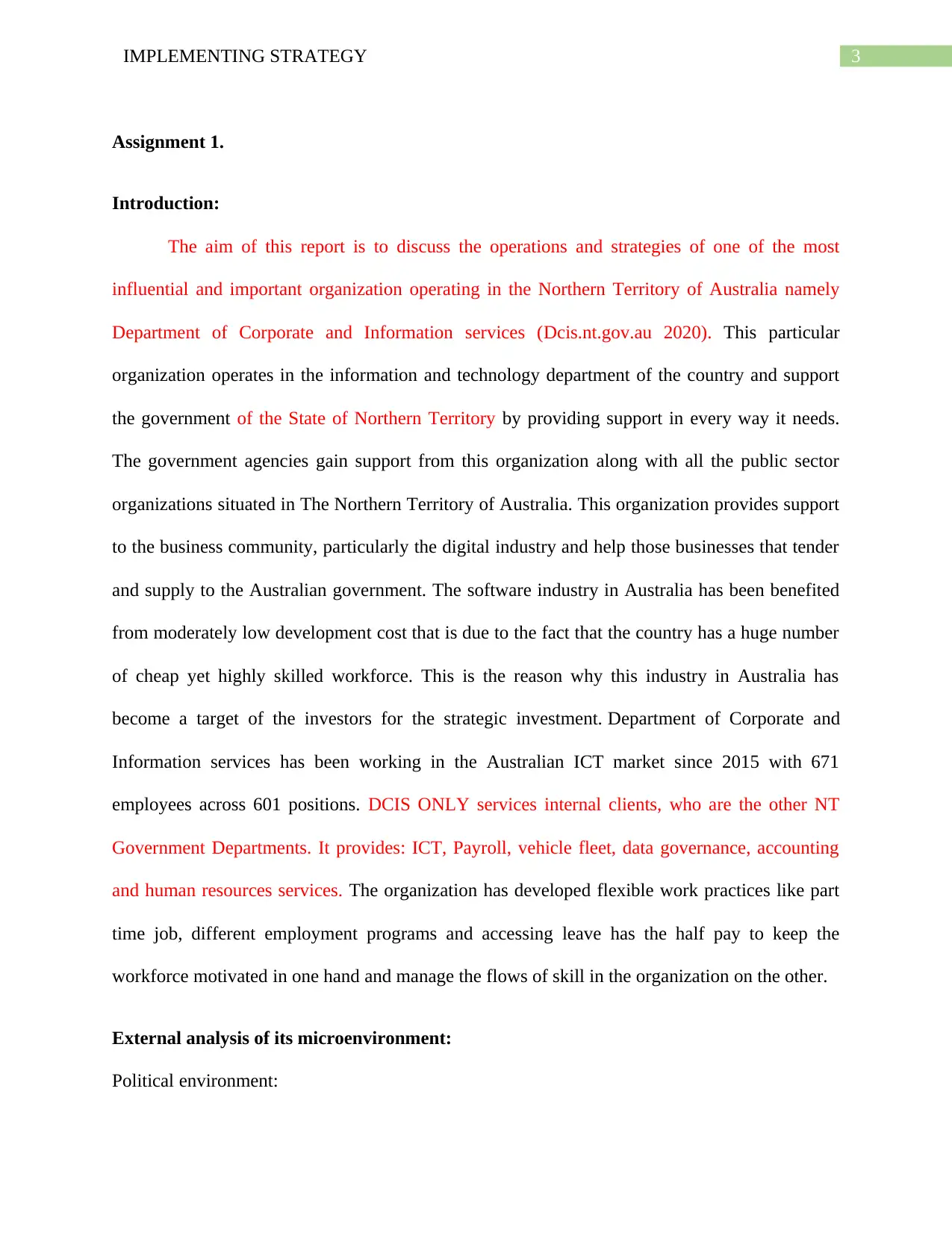
3IMPLEMENTING STRATEGY
Assignment 1.
Introduction:
The aim of this report is to discuss the operations and strategies of one of the most
influential and important organization operating in the Northern Territory of Australia namely
Department of Corporate and Information services (Dcis.nt.gov.au 2020). This particular
organization operates in the information and technology department of the country and support
the government of the State of Northern Territory by providing support in every way it needs.
The government agencies gain support from this organization along with all the public sector
organizations situated in The Northern Territory of Australia. This organization provides support
to the business community, particularly the digital industry and help those businesses that tender
and supply to the Australian government. The software industry in Australia has been benefited
from moderately low development cost that is due to the fact that the country has a huge number
of cheap yet highly skilled workforce. This is the reason why this industry in Australia has
become a target of the investors for the strategic investment. Department of Corporate and
Information services has been working in the Australian ICT market since 2015 with 671
employees across 601 positions. DCIS ONLY services internal clients, who are the other NT
Government Departments. It provides: ICT, Payroll, vehicle fleet, data governance, accounting
and human resources services. The organization has developed flexible work practices like part
time job, different employment programs and accessing leave has the half pay to keep the
workforce motivated in one hand and manage the flows of skill in the organization on the other.
External analysis of its microenvironment:
Political environment:
Assignment 1.
Introduction:
The aim of this report is to discuss the operations and strategies of one of the most
influential and important organization operating in the Northern Territory of Australia namely
Department of Corporate and Information services (Dcis.nt.gov.au 2020). This particular
organization operates in the information and technology department of the country and support
the government of the State of Northern Territory by providing support in every way it needs.
The government agencies gain support from this organization along with all the public sector
organizations situated in The Northern Territory of Australia. This organization provides support
to the business community, particularly the digital industry and help those businesses that tender
and supply to the Australian government. The software industry in Australia has been benefited
from moderately low development cost that is due to the fact that the country has a huge number
of cheap yet highly skilled workforce. This is the reason why this industry in Australia has
become a target of the investors for the strategic investment. Department of Corporate and
Information services has been working in the Australian ICT market since 2015 with 671
employees across 601 positions. DCIS ONLY services internal clients, who are the other NT
Government Departments. It provides: ICT, Payroll, vehicle fleet, data governance, accounting
and human resources services. The organization has developed flexible work practices like part
time job, different employment programs and accessing leave has the half pay to keep the
workforce motivated in one hand and manage the flows of skill in the organization on the other.
External analysis of its microenvironment:
Political environment:
Secure Best Marks with AI Grader
Need help grading? Try our AI Grader for instant feedback on your assignments.
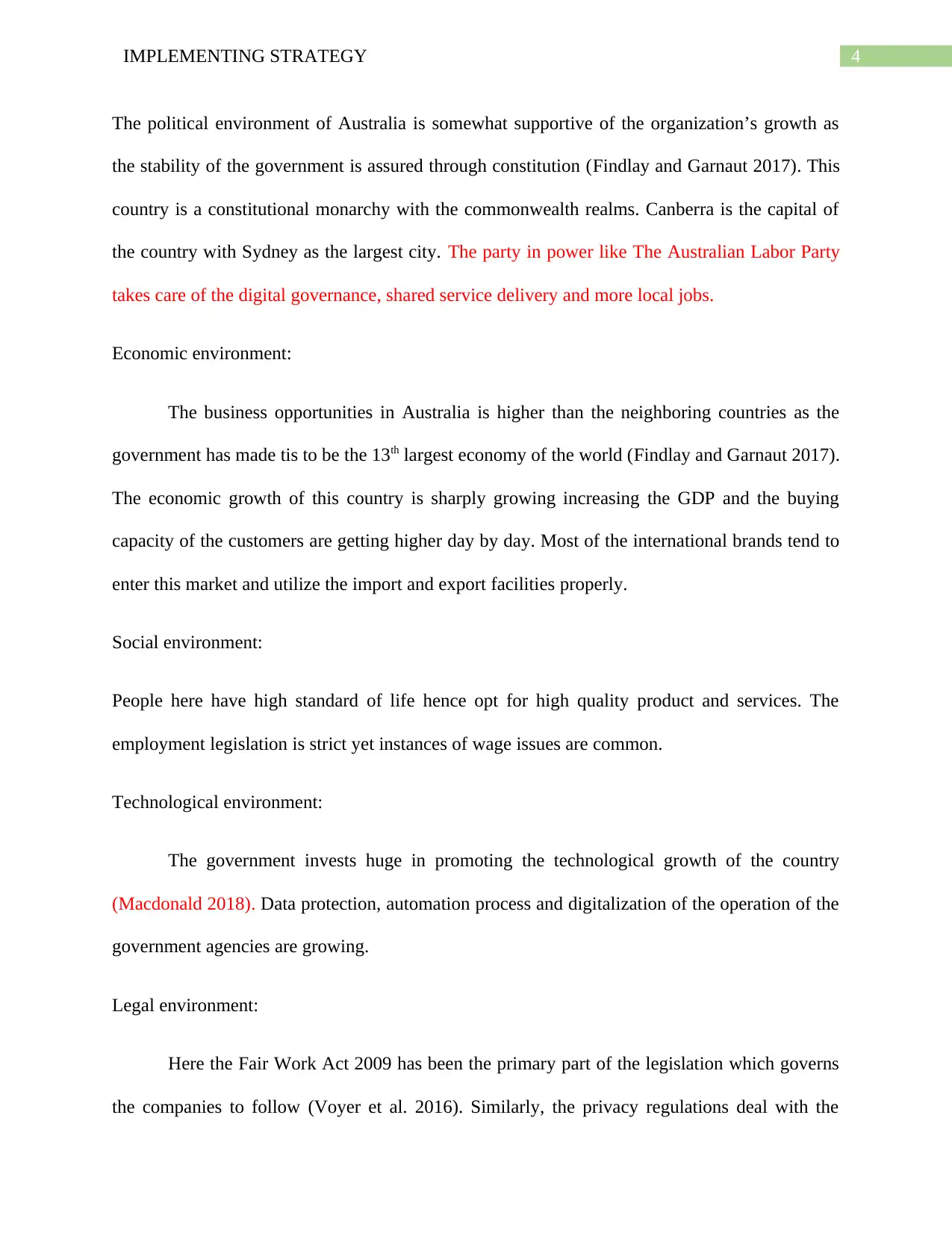
4IMPLEMENTING STRATEGY
The political environment of Australia is somewhat supportive of the organization’s growth as
the stability of the government is assured through constitution (Findlay and Garnaut 2017). This
country is a constitutional monarchy with the commonwealth realms. Canberra is the capital of
the country with Sydney as the largest city. The party in power like The Australian Labor Party
takes care of the digital governance, shared service delivery and more local jobs.
Economic environment:
The business opportunities in Australia is higher than the neighboring countries as the
government has made tis to be the 13th largest economy of the world (Findlay and Garnaut 2017).
The economic growth of this country is sharply growing increasing the GDP and the buying
capacity of the customers are getting higher day by day. Most of the international brands tend to
enter this market and utilize the import and export facilities properly.
Social environment:
People here have high standard of life hence opt for high quality product and services. The
employment legislation is strict yet instances of wage issues are common.
Technological environment:
The government invests huge in promoting the technological growth of the country
(Macdonald 2018). Data protection, automation process and digitalization of the operation of the
government agencies are growing.
Legal environment:
Here the Fair Work Act 2009 has been the primary part of the legislation which governs
the companies to follow (Voyer et al. 2016). Similarly, the privacy regulations deal with the
The political environment of Australia is somewhat supportive of the organization’s growth as
the stability of the government is assured through constitution (Findlay and Garnaut 2017). This
country is a constitutional monarchy with the commonwealth realms. Canberra is the capital of
the country with Sydney as the largest city. The party in power like The Australian Labor Party
takes care of the digital governance, shared service delivery and more local jobs.
Economic environment:
The business opportunities in Australia is higher than the neighboring countries as the
government has made tis to be the 13th largest economy of the world (Findlay and Garnaut 2017).
The economic growth of this country is sharply growing increasing the GDP and the buying
capacity of the customers are getting higher day by day. Most of the international brands tend to
enter this market and utilize the import and export facilities properly.
Social environment:
People here have high standard of life hence opt for high quality product and services. The
employment legislation is strict yet instances of wage issues are common.
Technological environment:
The government invests huge in promoting the technological growth of the country
(Macdonald 2018). Data protection, automation process and digitalization of the operation of the
government agencies are growing.
Legal environment:
Here the Fair Work Act 2009 has been the primary part of the legislation which governs
the companies to follow (Voyer et al. 2016). Similarly, the privacy regulations deal with the
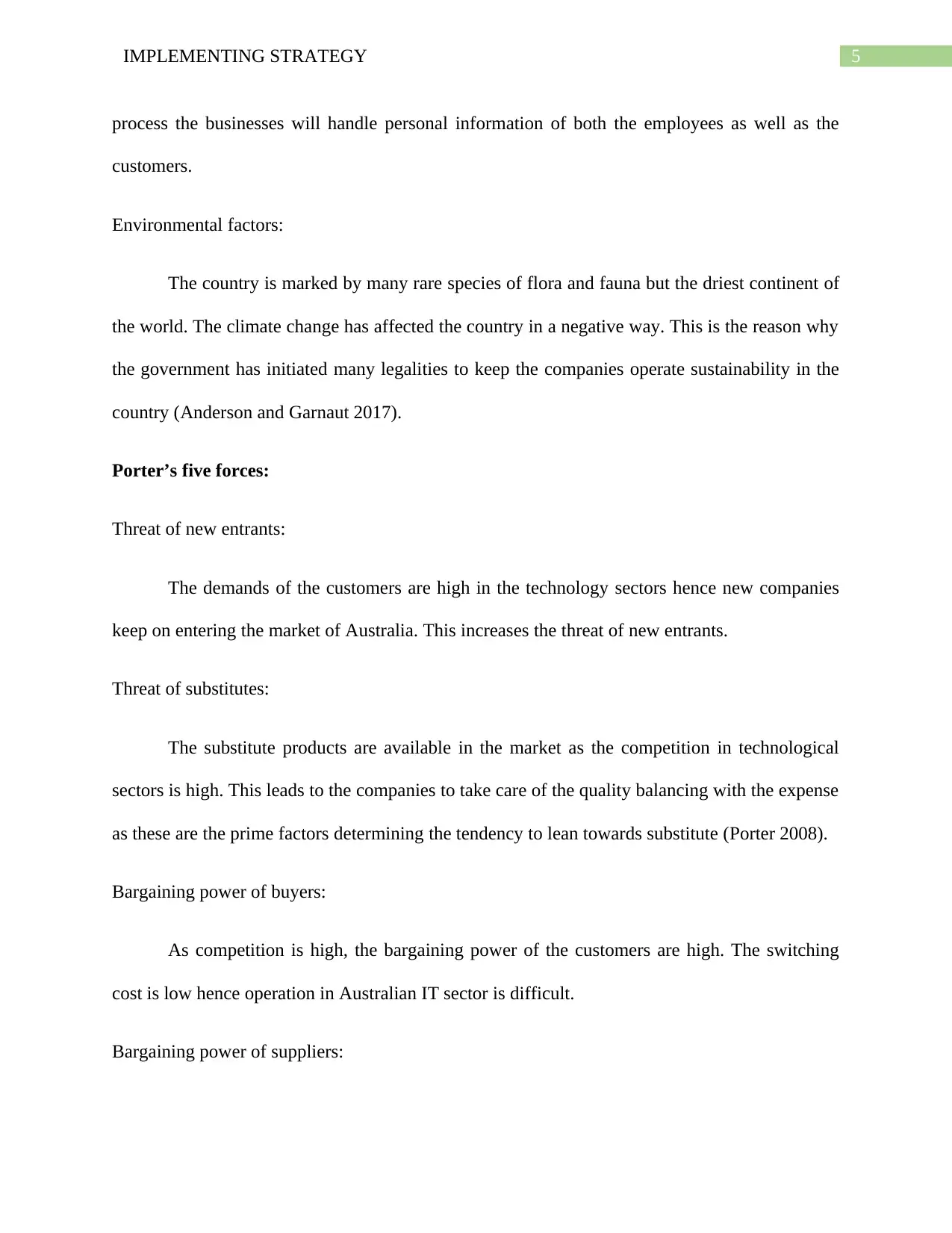
5IMPLEMENTING STRATEGY
process the businesses will handle personal information of both the employees as well as the
customers.
Environmental factors:
The country is marked by many rare species of flora and fauna but the driest continent of
the world. The climate change has affected the country in a negative way. This is the reason why
the government has initiated many legalities to keep the companies operate sustainability in the
country (Anderson and Garnaut 2017).
Porter’s five forces:
Threat of new entrants:
The demands of the customers are high in the technology sectors hence new companies
keep on entering the market of Australia. This increases the threat of new entrants.
Threat of substitutes:
The substitute products are available in the market as the competition in technological
sectors is high. This leads to the companies to take care of the quality balancing with the expense
as these are the prime factors determining the tendency to lean towards substitute (Porter 2008).
Bargaining power of buyers:
As competition is high, the bargaining power of the customers are high. The switching
cost is low hence operation in Australian IT sector is difficult.
Bargaining power of suppliers:
process the businesses will handle personal information of both the employees as well as the
customers.
Environmental factors:
The country is marked by many rare species of flora and fauna but the driest continent of
the world. The climate change has affected the country in a negative way. This is the reason why
the government has initiated many legalities to keep the companies operate sustainability in the
country (Anderson and Garnaut 2017).
Porter’s five forces:
Threat of new entrants:
The demands of the customers are high in the technology sectors hence new companies
keep on entering the market of Australia. This increases the threat of new entrants.
Threat of substitutes:
The substitute products are available in the market as the competition in technological
sectors is high. This leads to the companies to take care of the quality balancing with the expense
as these are the prime factors determining the tendency to lean towards substitute (Porter 2008).
Bargaining power of buyers:
As competition is high, the bargaining power of the customers are high. The switching
cost is low hence operation in Australian IT sector is difficult.
Bargaining power of suppliers:
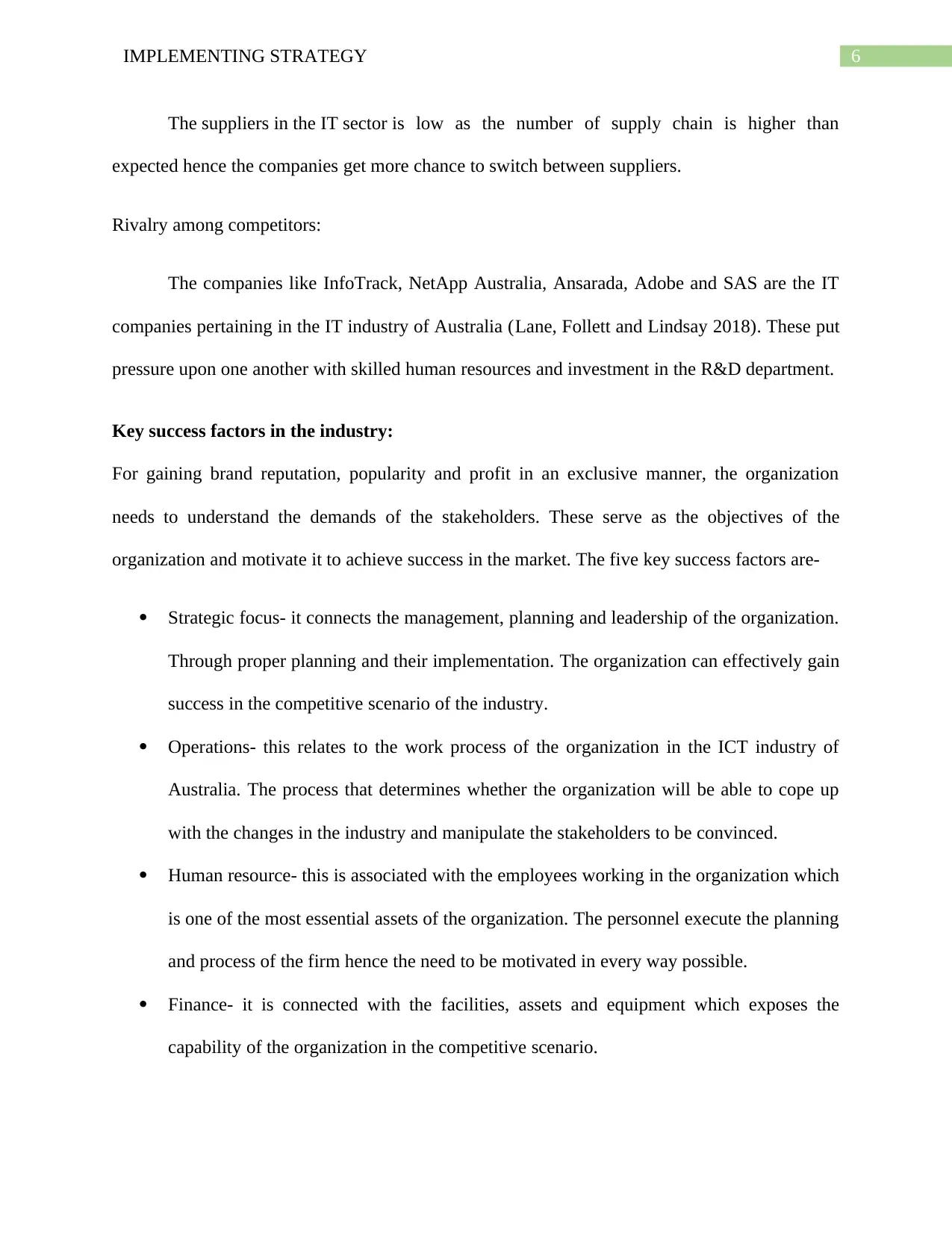
6IMPLEMENTING STRATEGY
The suppliers in the IT sector is low as the number of supply chain is higher than
expected hence the companies get more chance to switch between suppliers.
Rivalry among competitors:
The companies like InfoTrack, NetApp Australia, Ansarada, Adobe and SAS are the IT
companies pertaining in the IT industry of Australia (Lane, Follett and Lindsay 2018). These put
pressure upon one another with skilled human resources and investment in the R&D department.
Key success factors in the industry:
For gaining brand reputation, popularity and profit in an exclusive manner, the organization
needs to understand the demands of the stakeholders. These serve as the objectives of the
organization and motivate it to achieve success in the market. The five key success factors are-
Strategic focus- it connects the management, planning and leadership of the organization.
Through proper planning and their implementation. The organization can effectively gain
success in the competitive scenario of the industry.
Operations- this relates to the work process of the organization in the ICT industry of
Australia. The process that determines whether the organization will be able to cope up
with the changes in the industry and manipulate the stakeholders to be convinced.
Human resource- this is associated with the employees working in the organization which
is one of the most essential assets of the organization. The personnel execute the planning
and process of the firm hence the need to be motivated in every way possible.
Finance- it is connected with the facilities, assets and equipment which exposes the
capability of the organization in the competitive scenario.
The suppliers in the IT sector is low as the number of supply chain is higher than
expected hence the companies get more chance to switch between suppliers.
Rivalry among competitors:
The companies like InfoTrack, NetApp Australia, Ansarada, Adobe and SAS are the IT
companies pertaining in the IT industry of Australia (Lane, Follett and Lindsay 2018). These put
pressure upon one another with skilled human resources and investment in the R&D department.
Key success factors in the industry:
For gaining brand reputation, popularity and profit in an exclusive manner, the organization
needs to understand the demands of the stakeholders. These serve as the objectives of the
organization and motivate it to achieve success in the market. The five key success factors are-
Strategic focus- it connects the management, planning and leadership of the organization.
Through proper planning and their implementation. The organization can effectively gain
success in the competitive scenario of the industry.
Operations- this relates to the work process of the organization in the ICT industry of
Australia. The process that determines whether the organization will be able to cope up
with the changes in the industry and manipulate the stakeholders to be convinced.
Human resource- this is associated with the employees working in the organization which
is one of the most essential assets of the organization. The personnel execute the planning
and process of the firm hence the need to be motivated in every way possible.
Finance- it is connected with the facilities, assets and equipment which exposes the
capability of the organization in the competitive scenario.
Paraphrase This Document
Need a fresh take? Get an instant paraphrase of this document with our AI Paraphraser
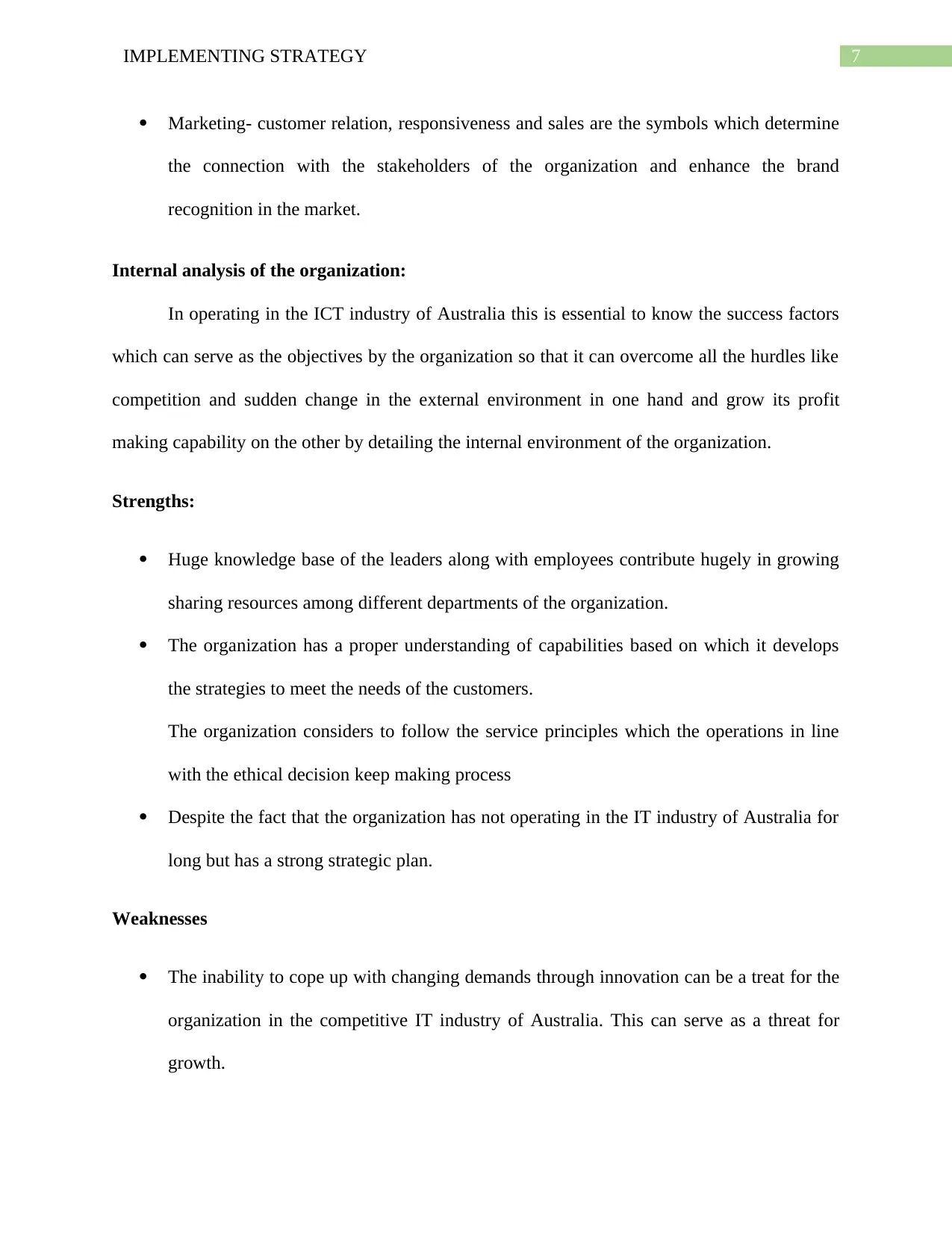
7IMPLEMENTING STRATEGY
Marketing- customer relation, responsiveness and sales are the symbols which determine
the connection with the stakeholders of the organization and enhance the brand
recognition in the market.
Internal analysis of the organization:
In operating in the ICT industry of Australia this is essential to know the success factors
which can serve as the objectives by the organization so that it can overcome all the hurdles like
competition and sudden change in the external environment in one hand and grow its profit
making capability on the other by detailing the internal environment of the organization.
Strengths:
Huge knowledge base of the leaders along with employees contribute hugely in growing
sharing resources among different departments of the organization.
The organization has a proper understanding of capabilities based on which it develops
the strategies to meet the needs of the customers.
The organization considers to follow the service principles which the operations in line
with the ethical decision keep making process
Despite the fact that the organization has not operating in the IT industry of Australia for
long but has a strong strategic plan.
Weaknesses
The inability to cope up with changing demands through innovation can be a treat for the
organization in the competitive IT industry of Australia. This can serve as a threat for
growth.
Marketing- customer relation, responsiveness and sales are the symbols which determine
the connection with the stakeholders of the organization and enhance the brand
recognition in the market.
Internal analysis of the organization:
In operating in the ICT industry of Australia this is essential to know the success factors
which can serve as the objectives by the organization so that it can overcome all the hurdles like
competition and sudden change in the external environment in one hand and grow its profit
making capability on the other by detailing the internal environment of the organization.
Strengths:
Huge knowledge base of the leaders along with employees contribute hugely in growing
sharing resources among different departments of the organization.
The organization has a proper understanding of capabilities based on which it develops
the strategies to meet the needs of the customers.
The organization considers to follow the service principles which the operations in line
with the ethical decision keep making process
Despite the fact that the organization has not operating in the IT industry of Australia for
long but has a strong strategic plan.
Weaknesses
The inability to cope up with changing demands through innovation can be a treat for the
organization in the competitive IT industry of Australia. This can serve as a threat for
growth.
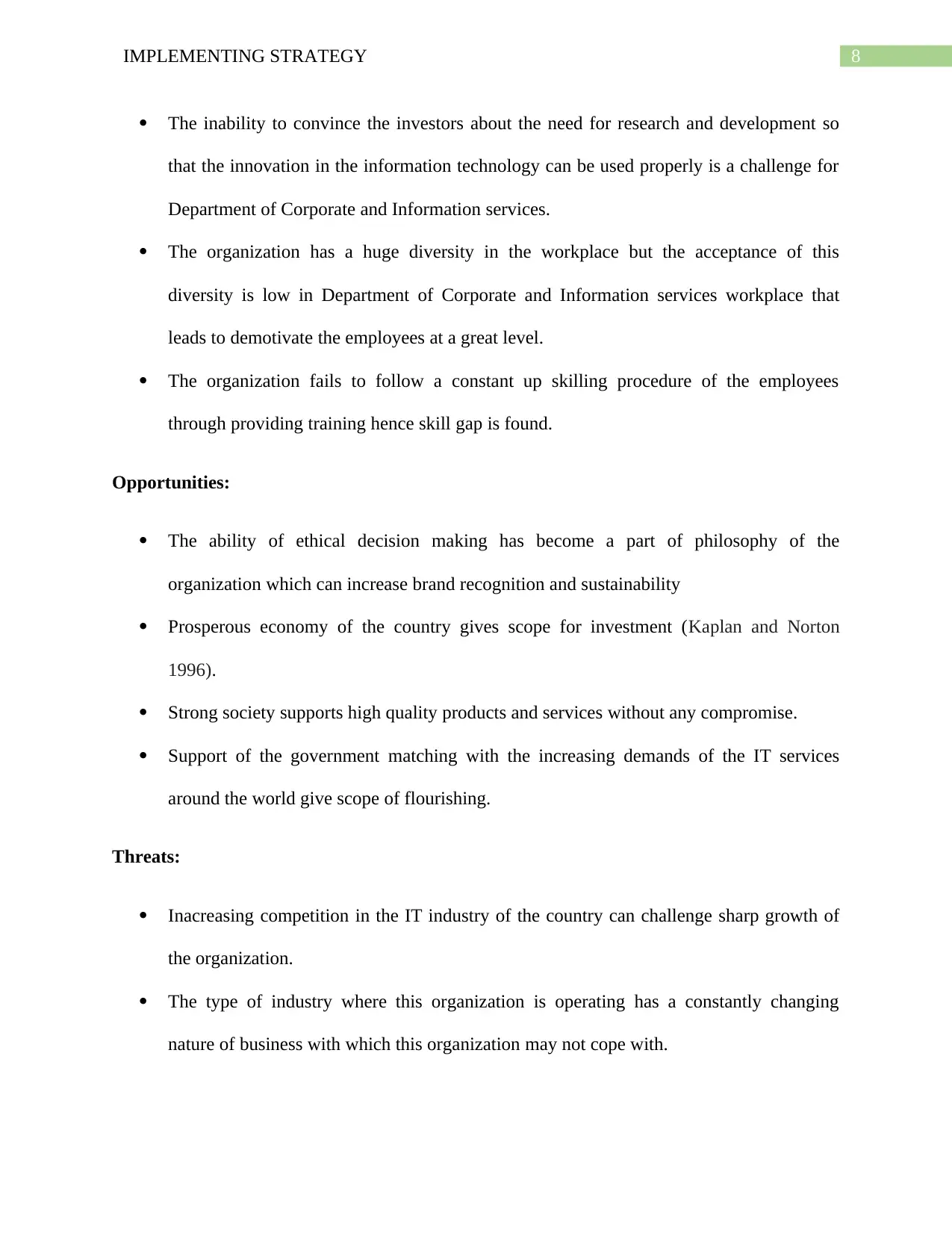
8IMPLEMENTING STRATEGY
The inability to convince the investors about the need for research and development so
that the innovation in the information technology can be used properly is a challenge for
Department of Corporate and Information services.
The organization has a huge diversity in the workplace but the acceptance of this
diversity is low in Department of Corporate and Information services workplace that
leads to demotivate the employees at a great level.
The organization fails to follow a constant up skilling procedure of the employees
through providing training hence skill gap is found.
Opportunities:
The ability of ethical decision making has become a part of philosophy of the
organization which can increase brand recognition and sustainability
Prosperous economy of the country gives scope for investment (Kaplan and Norton
1996).
Strong society supports high quality products and services without any compromise.
Support of the government matching with the increasing demands of the IT services
around the world give scope of flourishing.
Threats:
Inacreasing competition in the IT industry of the country can challenge sharp growth of
the organization.
The type of industry where this organization is operating has a constantly changing
nature of business with which this organization may not cope with.
The inability to convince the investors about the need for research and development so
that the innovation in the information technology can be used properly is a challenge for
Department of Corporate and Information services.
The organization has a huge diversity in the workplace but the acceptance of this
diversity is low in Department of Corporate and Information services workplace that
leads to demotivate the employees at a great level.
The organization fails to follow a constant up skilling procedure of the employees
through providing training hence skill gap is found.
Opportunities:
The ability of ethical decision making has become a part of philosophy of the
organization which can increase brand recognition and sustainability
Prosperous economy of the country gives scope for investment (Kaplan and Norton
1996).
Strong society supports high quality products and services without any compromise.
Support of the government matching with the increasing demands of the IT services
around the world give scope of flourishing.
Threats:
Inacreasing competition in the IT industry of the country can challenge sharp growth of
the organization.
The type of industry where this organization is operating has a constantly changing
nature of business with which this organization may not cope with.
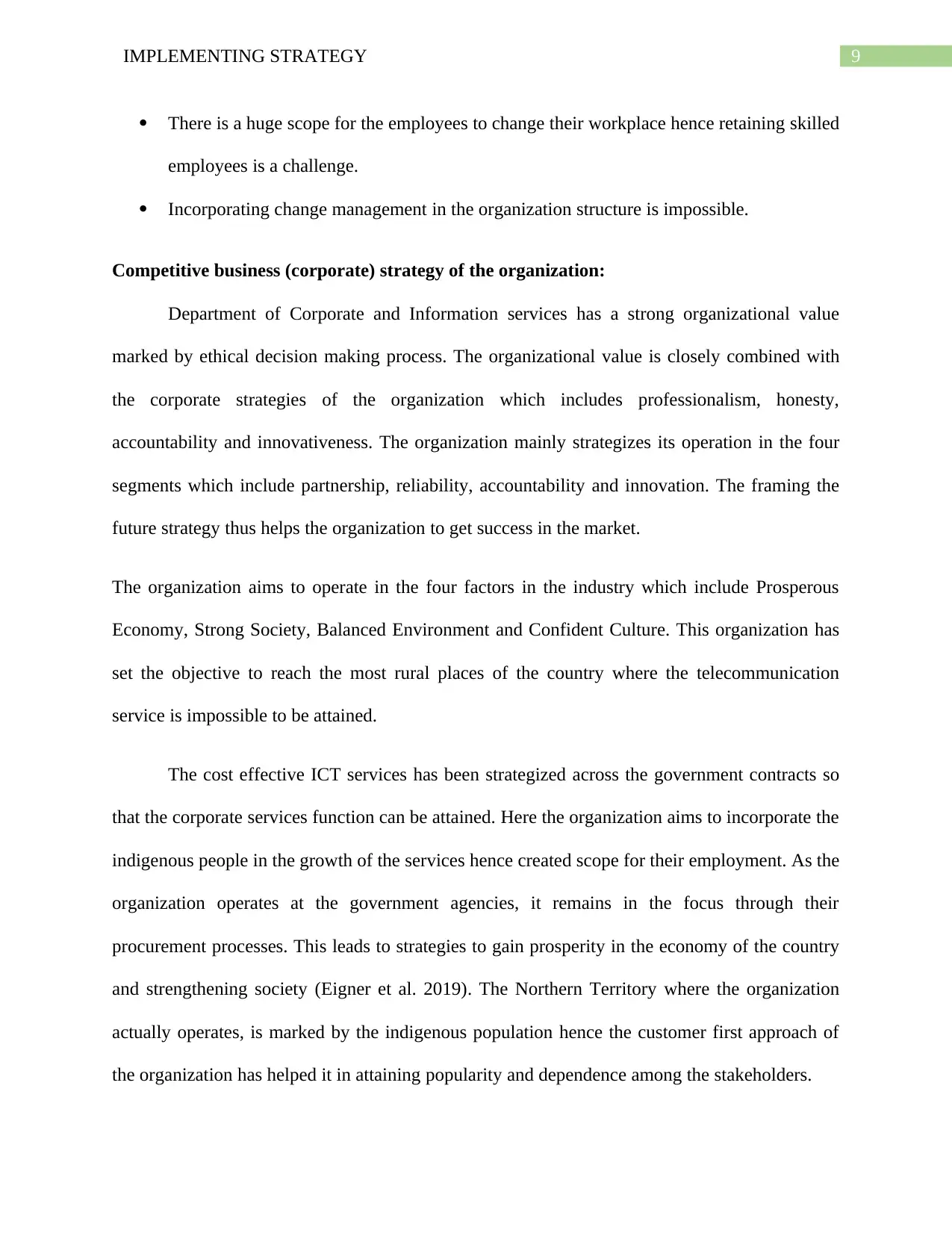
9IMPLEMENTING STRATEGY
There is a huge scope for the employees to change their workplace hence retaining skilled
employees is a challenge.
Incorporating change management in the organization structure is impossible.
Competitive business (corporate) strategy of the organization:
Department of Corporate and Information services has a strong organizational value
marked by ethical decision making process. The organizational value is closely combined with
the corporate strategies of the organization which includes professionalism, honesty,
accountability and innovativeness. The organization mainly strategizes its operation in the four
segments which include partnership, reliability, accountability and innovation. The framing the
future strategy thus helps the organization to get success in the market.
The organization aims to operate in the four factors in the industry which include Prosperous
Economy, Strong Society, Balanced Environment and Confident Culture. This organization has
set the objective to reach the most rural places of the country where the telecommunication
service is impossible to be attained.
The cost effective ICT services has been strategized across the government contracts so
that the corporate services function can be attained. Here the organization aims to incorporate the
indigenous people in the growth of the services hence created scope for their employment. As the
organization operates at the government agencies, it remains in the focus through their
procurement processes. This leads to strategies to gain prosperity in the economy of the country
and strengthening society (Eigner et al. 2019). The Northern Territory where the organization
actually operates, is marked by the indigenous population hence the customer first approach of
the organization has helped it in attaining popularity and dependence among the stakeholders.
There is a huge scope for the employees to change their workplace hence retaining skilled
employees is a challenge.
Incorporating change management in the organization structure is impossible.
Competitive business (corporate) strategy of the organization:
Department of Corporate and Information services has a strong organizational value
marked by ethical decision making process. The organizational value is closely combined with
the corporate strategies of the organization which includes professionalism, honesty,
accountability and innovativeness. The organization mainly strategizes its operation in the four
segments which include partnership, reliability, accountability and innovation. The framing the
future strategy thus helps the organization to get success in the market.
The organization aims to operate in the four factors in the industry which include Prosperous
Economy, Strong Society, Balanced Environment and Confident Culture. This organization has
set the objective to reach the most rural places of the country where the telecommunication
service is impossible to be attained.
The cost effective ICT services has been strategized across the government contracts so
that the corporate services function can be attained. Here the organization aims to incorporate the
indigenous people in the growth of the services hence created scope for their employment. As the
organization operates at the government agencies, it remains in the focus through their
procurement processes. This leads to strategies to gain prosperity in the economy of the country
and strengthening society (Eigner et al. 2019). The Northern Territory where the organization
actually operates, is marked by the indigenous population hence the customer first approach of
the organization has helped it in attaining popularity and dependence among the stakeholders.
Secure Best Marks with AI Grader
Need help grading? Try our AI Grader for instant feedback on your assignments.
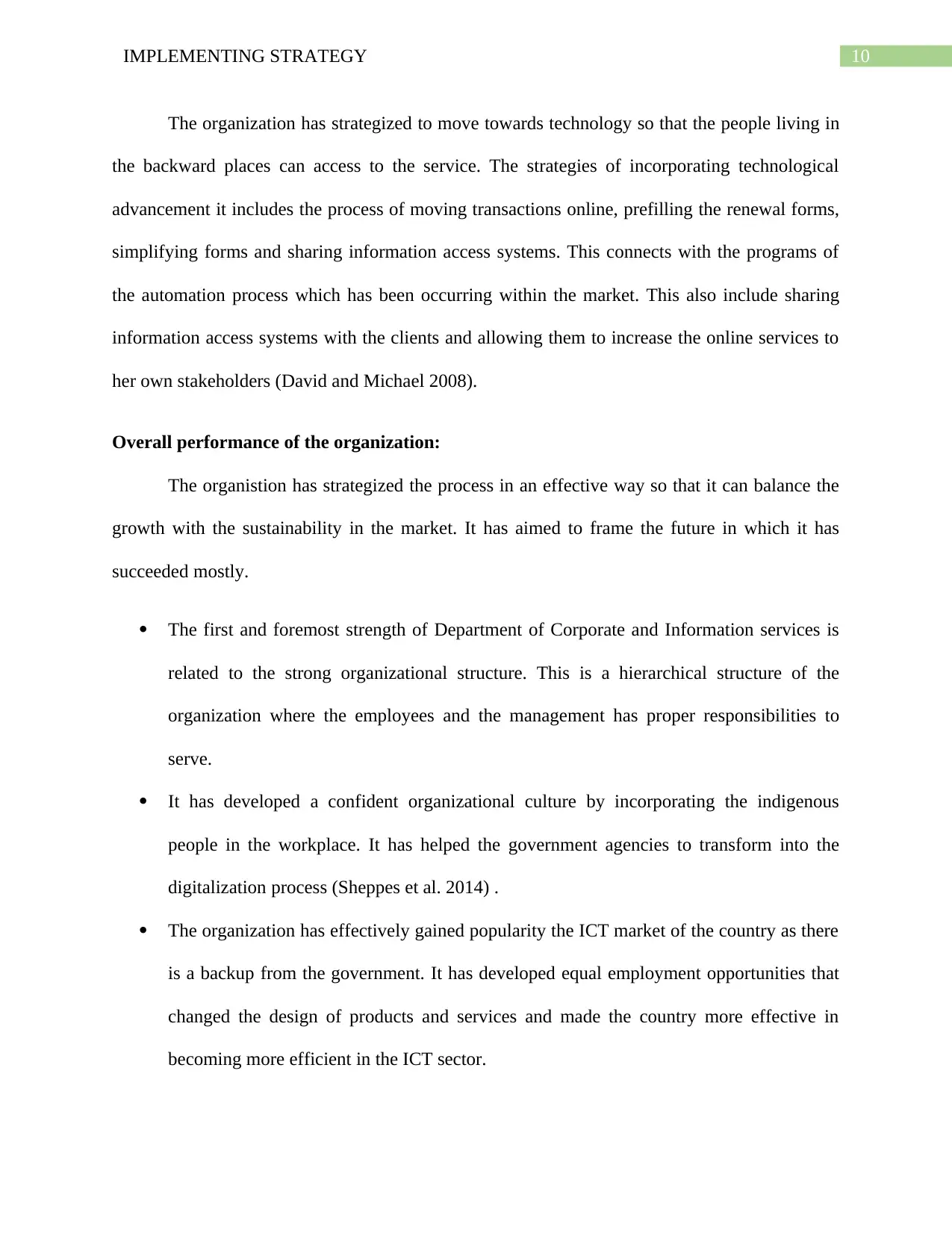
10IMPLEMENTING STRATEGY
The organization has strategized to move towards technology so that the people living in
the backward places can access to the service. The strategies of incorporating technological
advancement it includes the process of moving transactions online, prefilling the renewal forms,
simplifying forms and sharing information access systems. This connects with the programs of
the automation process which has been occurring within the market. This also include sharing
information access systems with the clients and allowing them to increase the online services to
her own stakeholders (David and Michael 2008).
Overall performance of the organization:
The organistion has strategized the process in an effective way so that it can balance the
growth with the sustainability in the market. It has aimed to frame the future in which it has
succeeded mostly.
The first and foremost strength of Department of Corporate and Information services is
related to the strong organizational structure. This is a hierarchical structure of the
organization where the employees and the management has proper responsibilities to
serve.
It has developed a confident organizational culture by incorporating the indigenous
people in the workplace. It has helped the government agencies to transform into the
digitalization process (Sheppes et al. 2014) .
The organization has effectively gained popularity the ICT market of the country as there
is a backup from the government. It has developed equal employment opportunities that
changed the design of products and services and made the country more effective in
becoming more efficient in the ICT sector.
The organization has strategized to move towards technology so that the people living in
the backward places can access to the service. The strategies of incorporating technological
advancement it includes the process of moving transactions online, prefilling the renewal forms,
simplifying forms and sharing information access systems. This connects with the programs of
the automation process which has been occurring within the market. This also include sharing
information access systems with the clients and allowing them to increase the online services to
her own stakeholders (David and Michael 2008).
Overall performance of the organization:
The organistion has strategized the process in an effective way so that it can balance the
growth with the sustainability in the market. It has aimed to frame the future in which it has
succeeded mostly.
The first and foremost strength of Department of Corporate and Information services is
related to the strong organizational structure. This is a hierarchical structure of the
organization where the employees and the management has proper responsibilities to
serve.
It has developed a confident organizational culture by incorporating the indigenous
people in the workplace. It has helped the government agencies to transform into the
digitalization process (Sheppes et al. 2014) .
The organization has effectively gained popularity the ICT market of the country as there
is a backup from the government. It has developed equal employment opportunities that
changed the design of products and services and made the country more effective in
becoming more efficient in the ICT sector.
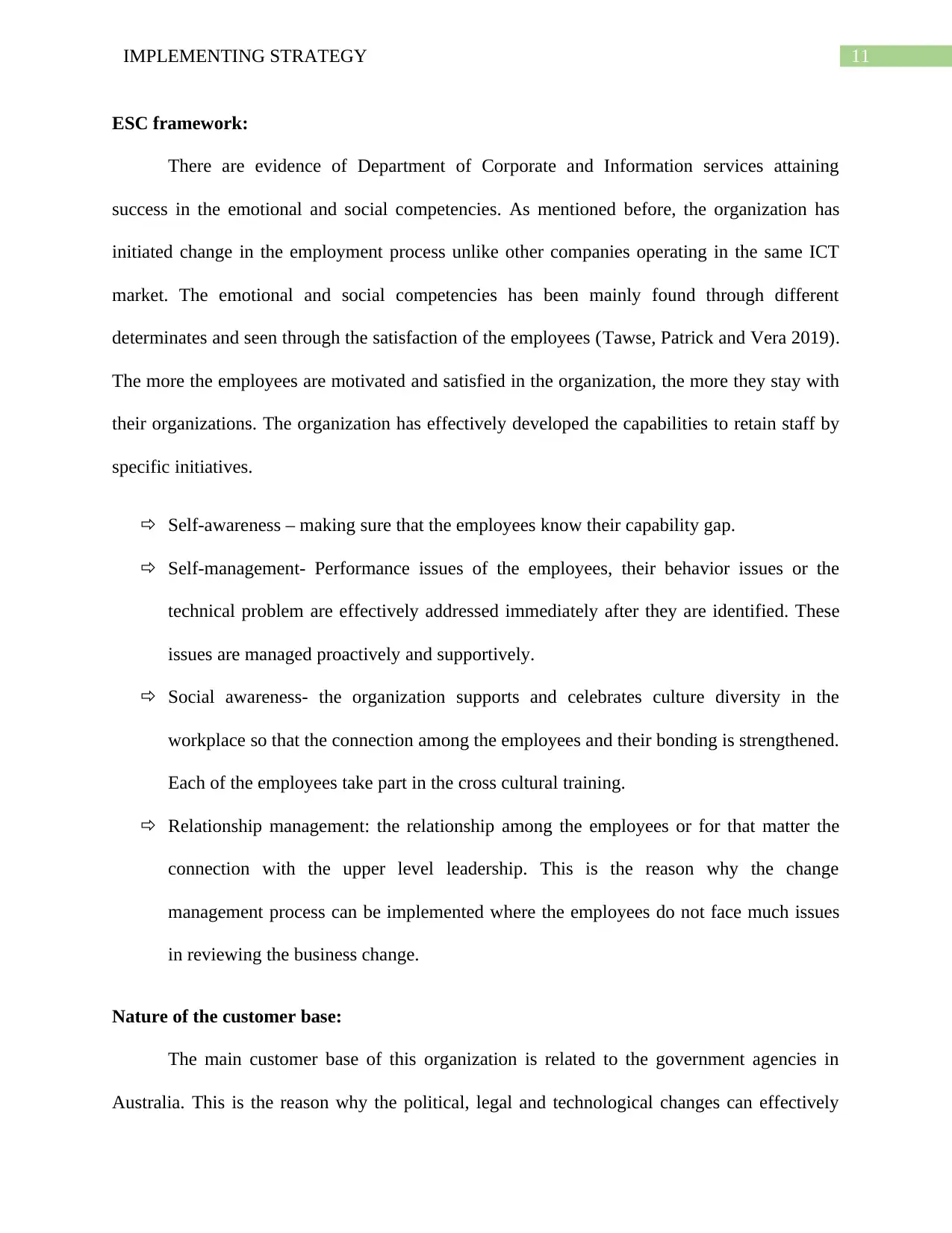
11IMPLEMENTING STRATEGY
ESC framework:
There are evidence of Department of Corporate and Information services attaining
success in the emotional and social competencies. As mentioned before, the organization has
initiated change in the employment process unlike other companies operating in the same ICT
market. The emotional and social competencies has been mainly found through different
determinates and seen through the satisfaction of the employees (Tawse, Patrick and Vera 2019).
The more the employees are motivated and satisfied in the organization, the more they stay with
their organizations. The organization has effectively developed the capabilities to retain staff by
specific initiatives.
Self-awareness – making sure that the employees know their capability gap.
Self-management- Performance issues of the employees, their behavior issues or the
technical problem are effectively addressed immediately after they are identified. These
issues are managed proactively and supportively.
Social awareness- the organization supports and celebrates culture diversity in the
workplace so that the connection among the employees and their bonding is strengthened.
Each of the employees take part in the cross cultural training.
Relationship management: the relationship among the employees or for that matter the
connection with the upper level leadership. This is the reason why the change
management process can be implemented where the employees do not face much issues
in reviewing the business change.
Nature of the customer base:
The main customer base of this organization is related to the government agencies in
Australia. This is the reason why the political, legal and technological changes can effectively
ESC framework:
There are evidence of Department of Corporate and Information services attaining
success in the emotional and social competencies. As mentioned before, the organization has
initiated change in the employment process unlike other companies operating in the same ICT
market. The emotional and social competencies has been mainly found through different
determinates and seen through the satisfaction of the employees (Tawse, Patrick and Vera 2019).
The more the employees are motivated and satisfied in the organization, the more they stay with
their organizations. The organization has effectively developed the capabilities to retain staff by
specific initiatives.
Self-awareness – making sure that the employees know their capability gap.
Self-management- Performance issues of the employees, their behavior issues or the
technical problem are effectively addressed immediately after they are identified. These
issues are managed proactively and supportively.
Social awareness- the organization supports and celebrates culture diversity in the
workplace so that the connection among the employees and their bonding is strengthened.
Each of the employees take part in the cross cultural training.
Relationship management: the relationship among the employees or for that matter the
connection with the upper level leadership. This is the reason why the change
management process can be implemented where the employees do not face much issues
in reviewing the business change.
Nature of the customer base:
The main customer base of this organization is related to the government agencies in
Australia. This is the reason why the political, legal and technological changes can effectively
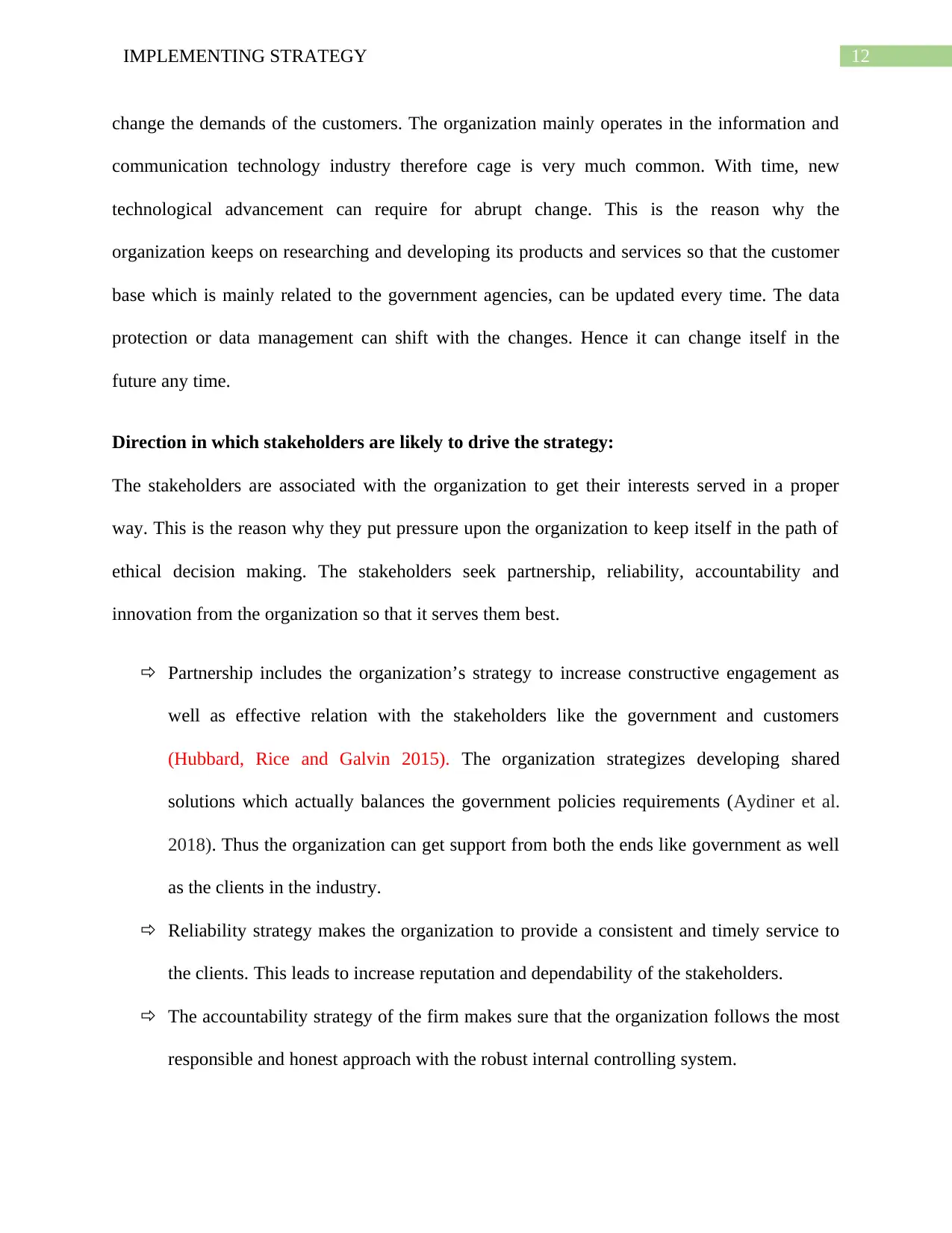
12IMPLEMENTING STRATEGY
change the demands of the customers. The organization mainly operates in the information and
communication technology industry therefore cage is very much common. With time, new
technological advancement can require for abrupt change. This is the reason why the
organization keeps on researching and developing its products and services so that the customer
base which is mainly related to the government agencies, can be updated every time. The data
protection or data management can shift with the changes. Hence it can change itself in the
future any time.
Direction in which stakeholders are likely to drive the strategy:
The stakeholders are associated with the organization to get their interests served in a proper
way. This is the reason why they put pressure upon the organization to keep itself in the path of
ethical decision making. The stakeholders seek partnership, reliability, accountability and
innovation from the organization so that it serves them best.
Partnership includes the organization’s strategy to increase constructive engagement as
well as effective relation with the stakeholders like the government and customers
(Hubbard, Rice and Galvin 2015). The organization strategizes developing shared
solutions which actually balances the government policies requirements (Aydiner et al.
2018). Thus the organization can get support from both the ends like government as well
as the clients in the industry.
Reliability strategy makes the organization to provide a consistent and timely service to
the clients. This leads to increase reputation and dependability of the stakeholders.
The accountability strategy of the firm makes sure that the organization follows the most
responsible and honest approach with the robust internal controlling system.
change the demands of the customers. The organization mainly operates in the information and
communication technology industry therefore cage is very much common. With time, new
technological advancement can require for abrupt change. This is the reason why the
organization keeps on researching and developing its products and services so that the customer
base which is mainly related to the government agencies, can be updated every time. The data
protection or data management can shift with the changes. Hence it can change itself in the
future any time.
Direction in which stakeholders are likely to drive the strategy:
The stakeholders are associated with the organization to get their interests served in a proper
way. This is the reason why they put pressure upon the organization to keep itself in the path of
ethical decision making. The stakeholders seek partnership, reliability, accountability and
innovation from the organization so that it serves them best.
Partnership includes the organization’s strategy to increase constructive engagement as
well as effective relation with the stakeholders like the government and customers
(Hubbard, Rice and Galvin 2015). The organization strategizes developing shared
solutions which actually balances the government policies requirements (Aydiner et al.
2018). Thus the organization can get support from both the ends like government as well
as the clients in the industry.
Reliability strategy makes the organization to provide a consistent and timely service to
the clients. This leads to increase reputation and dependability of the stakeholders.
The accountability strategy of the firm makes sure that the organization follows the most
responsible and honest approach with the robust internal controlling system.
Paraphrase This Document
Need a fresh take? Get an instant paraphrase of this document with our AI Paraphraser
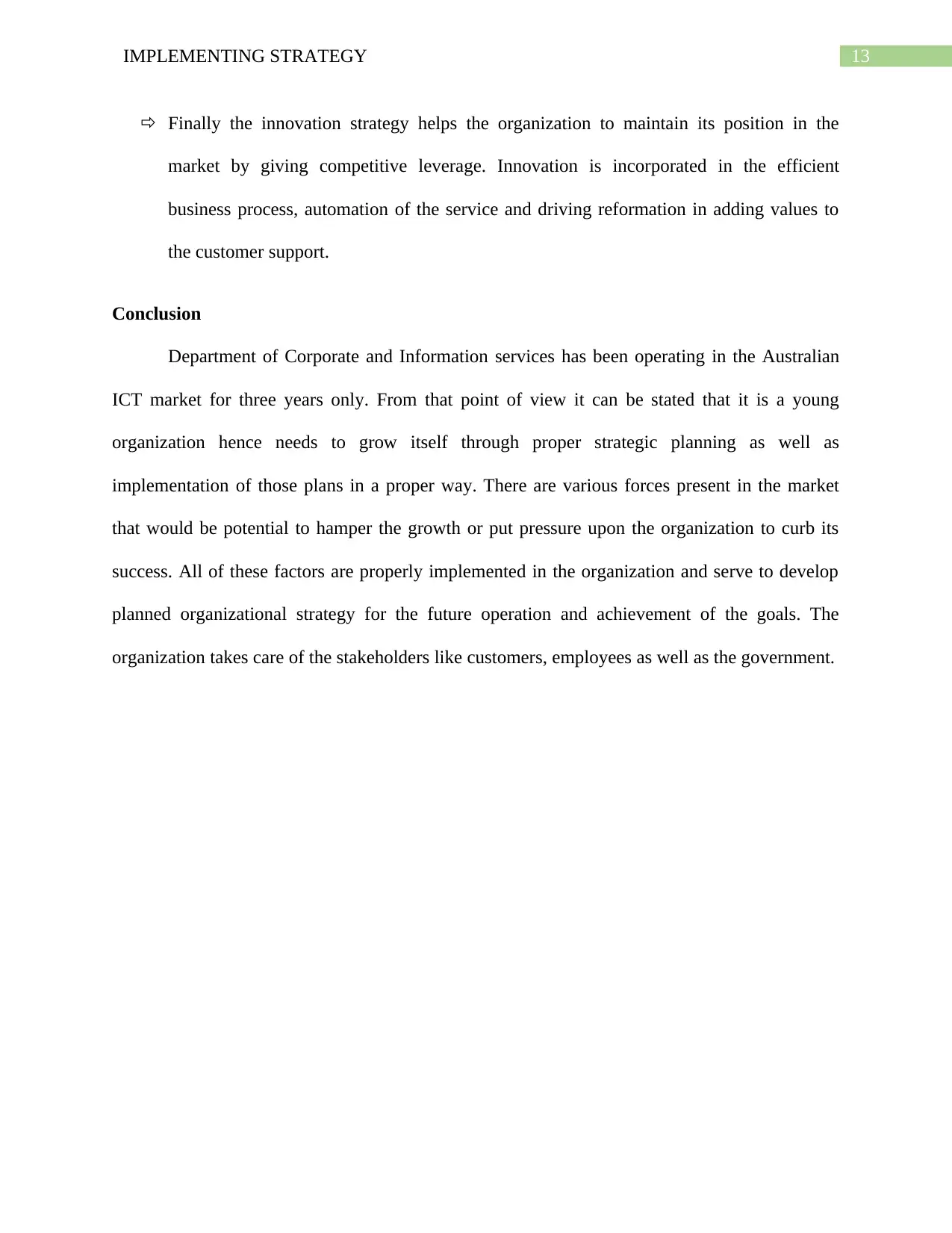
13IMPLEMENTING STRATEGY
Finally the innovation strategy helps the organization to maintain its position in the
market by giving competitive leverage. Innovation is incorporated in the efficient
business process, automation of the service and driving reformation in adding values to
the customer support.
Conclusion
Department of Corporate and Information services has been operating in the Australian
ICT market for three years only. From that point of view it can be stated that it is a young
organization hence needs to grow itself through proper strategic planning as well as
implementation of those plans in a proper way. There are various forces present in the market
that would be potential to hamper the growth or put pressure upon the organization to curb its
success. All of these factors are properly implemented in the organization and serve to develop
planned organizational strategy for the future operation and achievement of the goals. The
organization takes care of the stakeholders like customers, employees as well as the government.
Finally the innovation strategy helps the organization to maintain its position in the
market by giving competitive leverage. Innovation is incorporated in the efficient
business process, automation of the service and driving reformation in adding values to
the customer support.
Conclusion
Department of Corporate and Information services has been operating in the Australian
ICT market for three years only. From that point of view it can be stated that it is a young
organization hence needs to grow itself through proper strategic planning as well as
implementation of those plans in a proper way. There are various forces present in the market
that would be potential to hamper the growth or put pressure upon the organization to curb its
success. All of these factors are properly implemented in the organization and serve to develop
planned organizational strategy for the future operation and achievement of the goals. The
organization takes care of the stakeholders like customers, employees as well as the government.
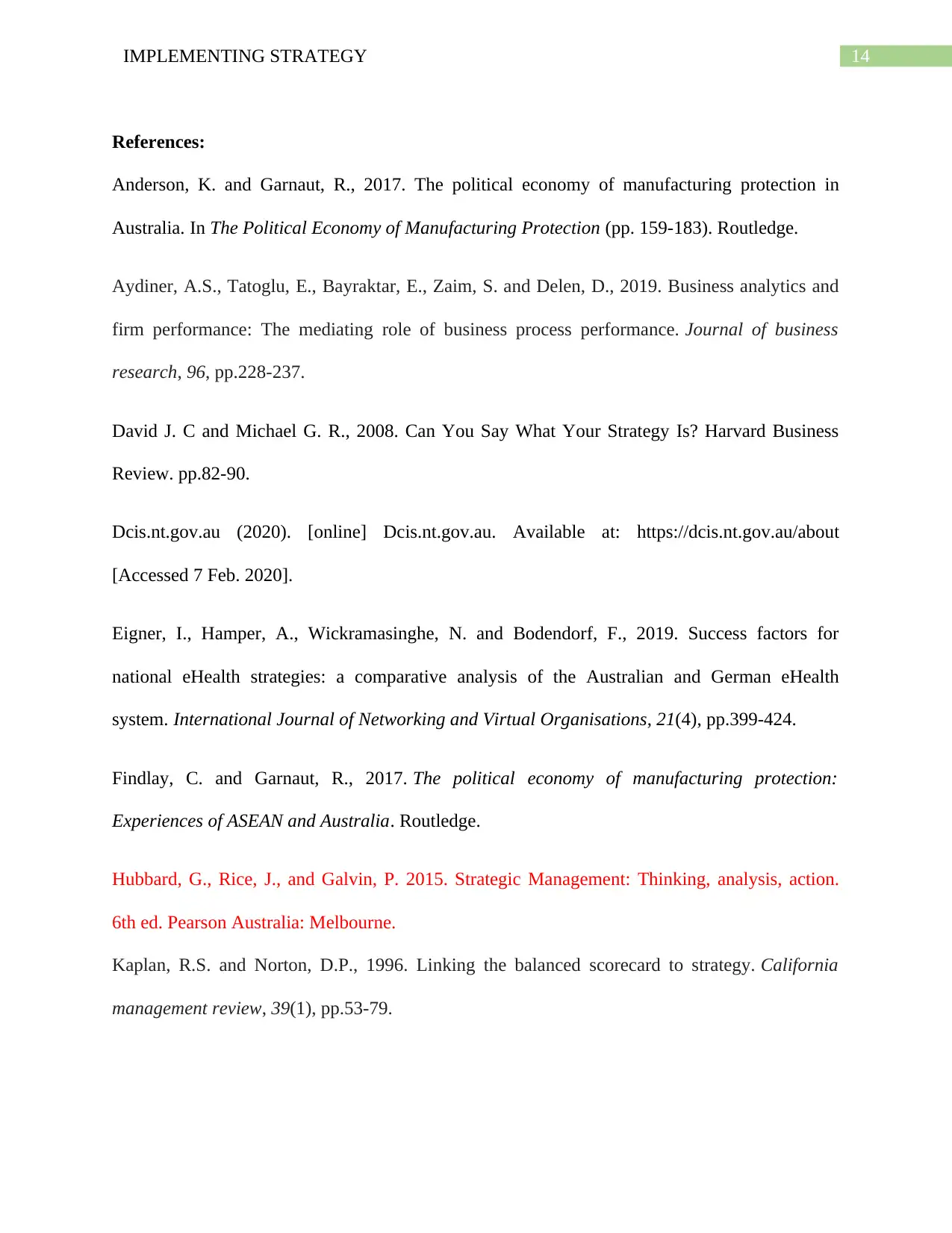
14IMPLEMENTING STRATEGY
References:
Anderson, K. and Garnaut, R., 2017. The political economy of manufacturing protection in
Australia. In The Political Economy of Manufacturing Protection (pp. 159-183). Routledge.
Aydiner, A.S., Tatoglu, E., Bayraktar, E., Zaim, S. and Delen, D., 2019. Business analytics and
firm performance: The mediating role of business process performance. Journal of business
research, 96, pp.228-237.
David J. C and Michael G. R., 2008. Can You Say What Your Strategy Is? Harvard Business
Review. pp.82-90.
Dcis.nt.gov.au (2020). [online] Dcis.nt.gov.au. Available at: https://dcis.nt.gov.au/about
[Accessed 7 Feb. 2020].
Eigner, I., Hamper, A., Wickramasinghe, N. and Bodendorf, F., 2019. Success factors for
national eHealth strategies: a comparative analysis of the Australian and German eHealth
system. International Journal of Networking and Virtual Organisations, 21(4), pp.399-424.
Findlay, C. and Garnaut, R., 2017. The political economy of manufacturing protection:
Experiences of ASEAN and Australia. Routledge.
Hubbard, G., Rice, J., and Galvin, P. 2015. Strategic Management: Thinking, analysis, action.
6th ed. Pearson Australia: Melbourne.
Kaplan, R.S. and Norton, D.P., 1996. Linking the balanced scorecard to strategy. California
management review, 39(1), pp.53-79.
References:
Anderson, K. and Garnaut, R., 2017. The political economy of manufacturing protection in
Australia. In The Political Economy of Manufacturing Protection (pp. 159-183). Routledge.
Aydiner, A.S., Tatoglu, E., Bayraktar, E., Zaim, S. and Delen, D., 2019. Business analytics and
firm performance: The mediating role of business process performance. Journal of business
research, 96, pp.228-237.
David J. C and Michael G. R., 2008. Can You Say What Your Strategy Is? Harvard Business
Review. pp.82-90.
Dcis.nt.gov.au (2020). [online] Dcis.nt.gov.au. Available at: https://dcis.nt.gov.au/about
[Accessed 7 Feb. 2020].
Eigner, I., Hamper, A., Wickramasinghe, N. and Bodendorf, F., 2019. Success factors for
national eHealth strategies: a comparative analysis of the Australian and German eHealth
system. International Journal of Networking and Virtual Organisations, 21(4), pp.399-424.
Findlay, C. and Garnaut, R., 2017. The political economy of manufacturing protection:
Experiences of ASEAN and Australia. Routledge.
Hubbard, G., Rice, J., and Galvin, P. 2015. Strategic Management: Thinking, analysis, action.
6th ed. Pearson Australia: Melbourne.
Kaplan, R.S. and Norton, D.P., 1996. Linking the balanced scorecard to strategy. California
management review, 39(1), pp.53-79.
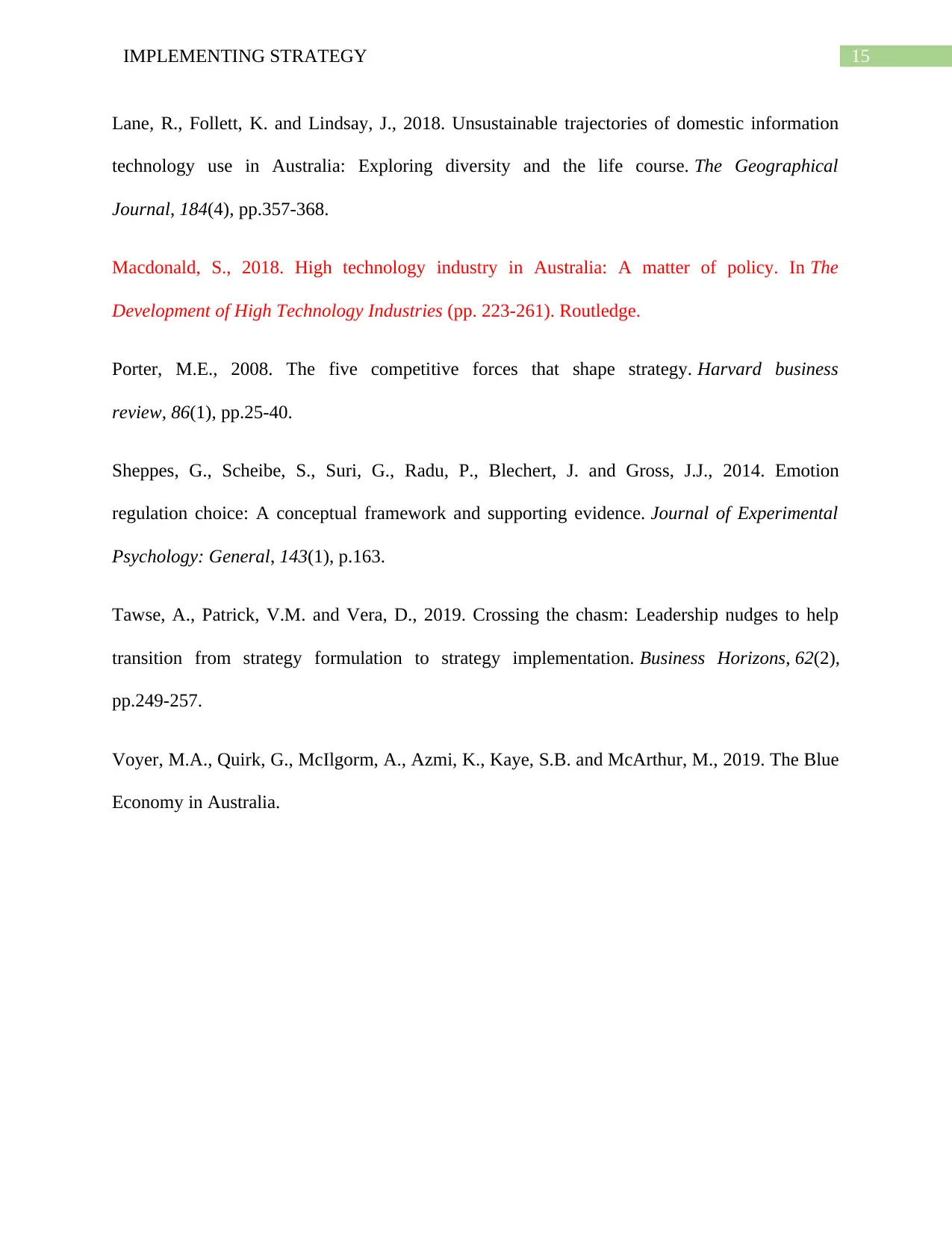
15IMPLEMENTING STRATEGY
Lane, R., Follett, K. and Lindsay, J., 2018. Unsustainable trajectories of domestic information
technology use in Australia: Exploring diversity and the life course. The Geographical
Journal, 184(4), pp.357-368.
Macdonald, S., 2018. High technology industry in Australia: A matter of policy. In The
Development of High Technology Industries (pp. 223-261). Routledge.
Porter, M.E., 2008. The five competitive forces that shape strategy. Harvard business
review, 86(1), pp.25-40.
Sheppes, G., Scheibe, S., Suri, G., Radu, P., Blechert, J. and Gross, J.J., 2014. Emotion
regulation choice: A conceptual framework and supporting evidence. Journal of Experimental
Psychology: General, 143(1), p.163.
Tawse, A., Patrick, V.M. and Vera, D., 2019. Crossing the chasm: Leadership nudges to help
transition from strategy formulation to strategy implementation. Business Horizons, 62(2),
pp.249-257.
Voyer, M.A., Quirk, G., McIlgorm, A., Azmi, K., Kaye, S.B. and McArthur, M., 2019. The Blue
Economy in Australia.
Lane, R., Follett, K. and Lindsay, J., 2018. Unsustainable trajectories of domestic information
technology use in Australia: Exploring diversity and the life course. The Geographical
Journal, 184(4), pp.357-368.
Macdonald, S., 2018. High technology industry in Australia: A matter of policy. In The
Development of High Technology Industries (pp. 223-261). Routledge.
Porter, M.E., 2008. The five competitive forces that shape strategy. Harvard business
review, 86(1), pp.25-40.
Sheppes, G., Scheibe, S., Suri, G., Radu, P., Blechert, J. and Gross, J.J., 2014. Emotion
regulation choice: A conceptual framework and supporting evidence. Journal of Experimental
Psychology: General, 143(1), p.163.
Tawse, A., Patrick, V.M. and Vera, D., 2019. Crossing the chasm: Leadership nudges to help
transition from strategy formulation to strategy implementation. Business Horizons, 62(2),
pp.249-257.
Voyer, M.A., Quirk, G., McIlgorm, A., Azmi, K., Kaye, S.B. and McArthur, M., 2019. The Blue
Economy in Australia.
Secure Best Marks with AI Grader
Need help grading? Try our AI Grader for instant feedback on your assignments.
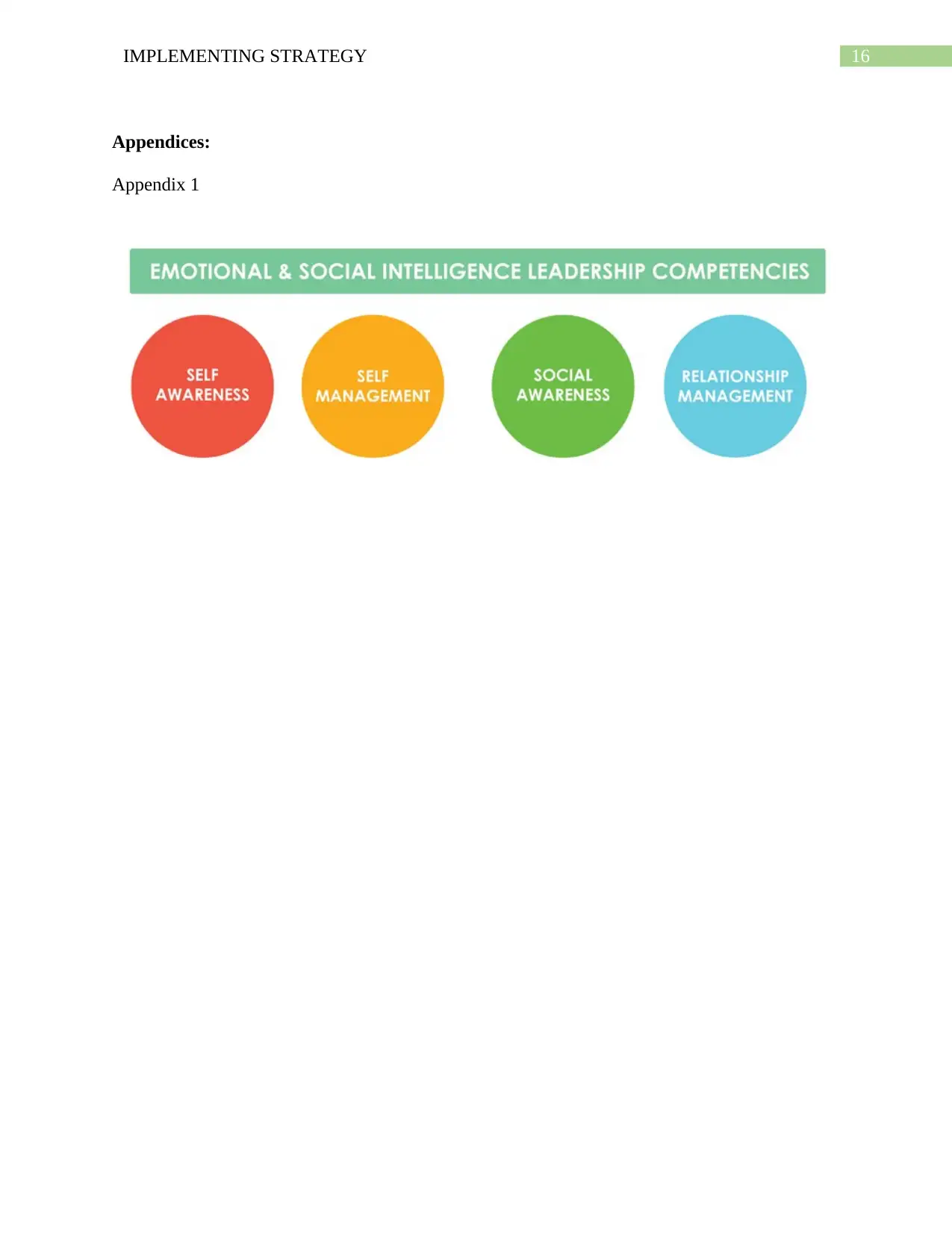
16IMPLEMENTING STRATEGY
Appendices:
Appendix 1
Appendices:
Appendix 1
1 out of 17
Related Documents
Your All-in-One AI-Powered Toolkit for Academic Success.
+13062052269
info@desklib.com
Available 24*7 on WhatsApp / Email
![[object Object]](/_next/static/media/star-bottom.7253800d.svg)
Unlock your academic potential
© 2024 | Zucol Services PVT LTD | All rights reserved.





